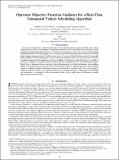Operator Objective Function Guidance for a Real-time Unmanned Vehicle Scheduling Algorithm
Author(s)
Clare, A.S.; Cummings, M.L.; How, J.; Whitten, A.; Toupet, O.
DownloadAIAA-61638-316.pdf (1.162Mb)
Metadata
Show full item recordAbstract
Advances in autonomy have made it possible to invert the typical operator-to-unmanned-vehicle ratio so that asingle operator can now control multiple heterogeneous unmanned vehicles. Algorithms used in unmanned-vehicle path planning and task allocation typically have an objective function that only takes into account variables initially identified by designers with set weightings. This can make the algorithm seemingly opaque to an operator and brittle under changing mission priorities. To address these issues, it is proposed that allowing operators to dynamically modify objective function weightings of an automated planner during a mission can have performance benefits.
A multiple-unmanned-vehicle simulation test bed was modified so that operators could either choose one variable or choose any combination of equally weighted variables for the automated planner to use in evaluating mission plans. Results from a human-participant experiment showed that operators rated their performance and confidence highest when using the dynamic objective function with multiple objectives. Allowing operators to adjust multiple objectives resulted in enhanced situational awareness, increased spare mental capacity, fewer interventions to modify the objective function, and no significant differences in mission performance. Adding this form of flexibility and transparency to automation in future unmanned vehicle systems could improve performance, engender operator trust, and reduce errors.
Date issued
2012-12Publisher
AIAA Journal of Aerospace Computing
Citation
Clare, A.S., Cummings, M.L., How, J., Whitten, A., and Toupet ,O., Operator Objective Function Guidance for a Real-time Unmanned Vehicle Scheduling Algorithm, AIAA Journal of Aerospace Computing, Information and Communication, Vol. 9, No.4, pp. 161-173, 2012.
Keywords
autonomy, unmanned-vehicle, multiple-unmanned-vehicle